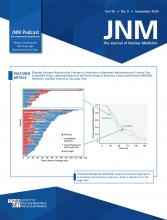In a 79-y-old man with metastatic castration-resistant prostate cancer and a history of bilateral nephrectomy for renal cell carcinoma, undergoing thrice-weekly hemodialysis, [68Ga]Ga-PSMA-11 PET revealed intense prostate-specific membrane antigen–avid lesions (Fig. 1A). He received 2 cycles of [177Lu]Lu-PSMA-617, with a 60% dose reduction to 3.1 GBq (40% of the standard dose) in each cycle (1). Regular hemodialysis persisted throughout the treatment at specified intervals. After therapy, the patient’s prostate-specific antigen level decreased by over 90% and was sustained for 4–5 mo. However, he experienced grade 4 thrombocytopenia and severe infections, persisting for several weeks. Because of these adverse effects, [177Lu]Lu-PSMA-617 was temporarily halted.
(A) [68Ga]Ga-PSMA-11 PET scan showed metastases in bone (highest SUVmax, 52.27), paraaortic lymph nodes (SUVmax, 11.39), pelvic lymph nodes (SUVmax, 26.82), left adrenal gland (SUXmax, 44.30), and lower right lung (SUVmax, 7.86), as well as physiologic uptake in bowels (arrow). (B) Time–activity curve and protocol of administration, hemodialysis, and pharmacokinetic measurements.
In the second cycle, we assessed whole-body and excreted activity and biologic effective half-life by an indirect approach involving the measurement of residual activity in the patient’s body at 4 distinct time points using a γ-camera (Symbia T; Siemens Healthineers) (1). The decay-corrected residual activity was 45.1% at 144 h after infusion, with the last hemodialysis session conducted 99–102 h after infusion. The whole-body effective half-life was 108.3 h (Fig. 1B).
In this patient, a 60% dose reduction, the lowest documented in the literature (2,3), resulted in unexpected bone marrow toxicity. Additionally, the observed effective half-life and residual activity exceeded previous findings in patients with normal renal function (1), suggesting delayed clearance of [177Lu]Lu-PSMA-617 in this hemodialysis patient.
DISCLOSURE
No potential conflict of interest relevant to this article was reported.
Footnotes
Published online Apr. 18, 2024.
- © 2024 by the Society of Nuclear Medicine and Molecular Imaging.
- Received for publication January 30, 2024.
- Accepted for publication April 10, 2024.








